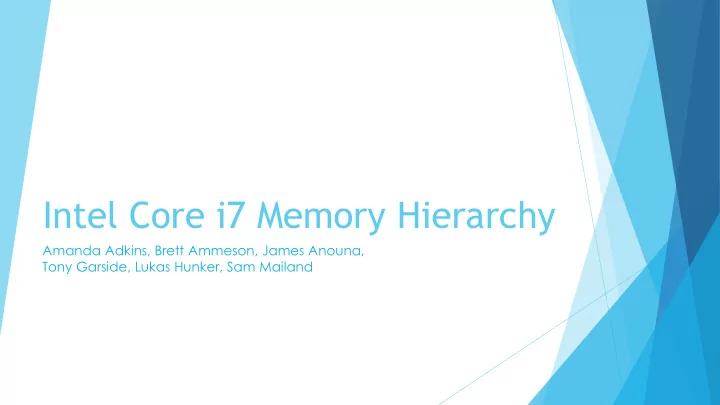

Intel Core i7 Memory Hierarchy Amanda Adkins, Brett Ammeson, James Anouna, Tony Garside, Lukas Hunker, Sam Mailand
Intel i7 Timeline 2011 2013 2015 • Nehalem • Ivy Bridge • Broadwell • Sandy • Haswell • Skylake Bridge 2008 2012 2015
Core i7 Basic Structure 4 cores Hyper threaded – 8 threads Pipelined with 16 stages
Footprint Nehalem Haswell (Fourth Gen) Nehalem (First Gen)
Major Developments
Increased Cache Bandwidth
Intel Core i7 Caching Basics Intel core i7 processors feature three levels of caching. Separate L1 and L2 cache for each core. L1 cache broken up into to halves, instruction/data. L3 cache shared among all cores and is inclusive.
Virtual Addressing
Physical Addressing
N-way set associativity (Review) Multiple entries per index Narrows search area needed to find unused slot i7 4790 L1 4x32 KB 8-way L2 4/256 KB 8-way L3 shared 8 MB 16-way
Intel's core i7 TLB design Memory cache that stores recent translations of virtual memory to physical addresses for faster retrieval. Uses a 2 level cache system L2 TLB ( Services misses in L1 DTLB) L1 TLB Can hold translations for 4KB and 2 MB pages Divided into 2 parts (vs. only 4KB) Data TLB: 64 4KB entries 1024 entries (vs. 512) Instruction TLB: 128 4KB entries 8-way associative (vs. 4-way)
TLB Comparisons between generations Nehalem Sandy Bridge and Ivy Bridge Haswell
Pseudo-LRU (Intel's core i7 caching algorithm) One bit per cache line Resets after all lines' bit is set Lowest line index with a '0' replaced
Port 2 and 3 are the Address Generation Units Port 4 for writing data from the core to the L1 Cache Additional port added to Haswell Haswell can sustain 2 loads and 1 store per cycle "under nearly any circumstances" Forwarding latency for AVX loads decreased from 2 to 1 cycle AVX: Set of instructions for doing SIMD operations on Intel CPUs 4 Split line buffers to resolve unaligned loads (vs 2 in Sandy-bridge) Decrease impact of unaligned access
Haswell L1 Cache 32 kb 8 way associative Writeback TLB access & cache tag can occur in parallel Does not suffer from bank conflicts (unlike Sandy Bridge) Minimum latency: 4 cycles (same as Sandy-Bridge) Minimum lock latency of haswell is 12 cycles (sandy-bridge was 16)
Haswell L2 Cache Bandwidth doubled Can deliver 64 bit line to data or instruction cache every cycle 11 cycle latency 256 KB for each cache
Haswell L3 Cache Shared between all cores Size varies between models and generations between 6MB and 15MB Most Haswell models have an 8MB cache Size reduced for power efficiency
Shared Data Transactional Synchronization Extensions Transactional memory Hardware Lock Elision Backwards Compatible, Windows only Uses instruction prefixes to lock and release Restricted Transactional Memory Newer, more flexible Fallback code in case of failure
Pre-fetching Fetch Instructions/Data before needed On a miss 2 blocks are fetched If successful, miss will grab from buffer, and pre-fetch next block
Memory Hierarchy Access Steps
Cache hit! We’re done. Latency: ~4 clock cycles OR Cache miss. Move on to L2 cache.
Cache hit! We’re done. Latency: ~10 clock cycles OR Cache miss. Move on to L3 cache.
Cache hit! We’re done. Latency: ~35 clock cycles Block is placed in L1 and L3 cache OR Cache miss. Memory access is initiated.
We’re done. Latency: ~135 clock cycles Block is placed in L1 and L3 cache.
Generation 5 (Broadwell) Currently mobile only (Lower power systems) Two cores Shrunk to 14 nm Power Consumption down to 15 w No low-end desktop processors Extended instruction set
Future Releases Broadwell Desktop Many manufacturers plan to skip Possibly due to lack of low-end offerings Skylake Second half of 2015
Conclusion Why is it faster? Increased Bandwidth Doubled the associativity in L2 TLB Tri Gate Transistors Smaller chip size Lower power requirements Decreased L3 Cache Size
Questions?
Recommend
More recommend